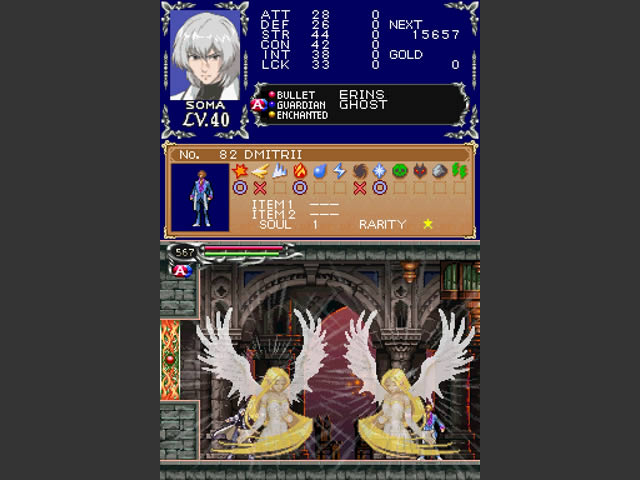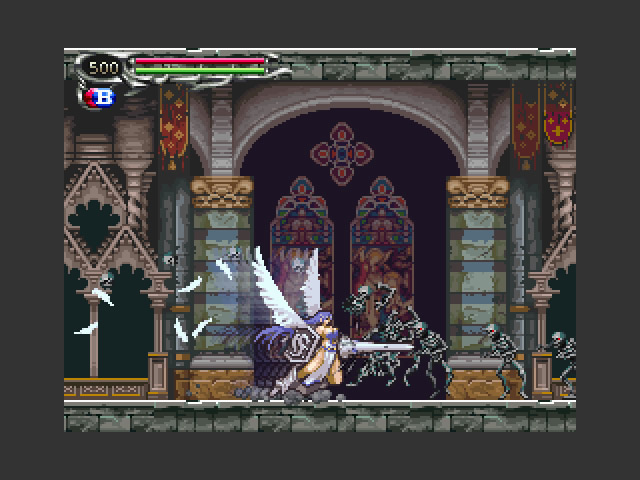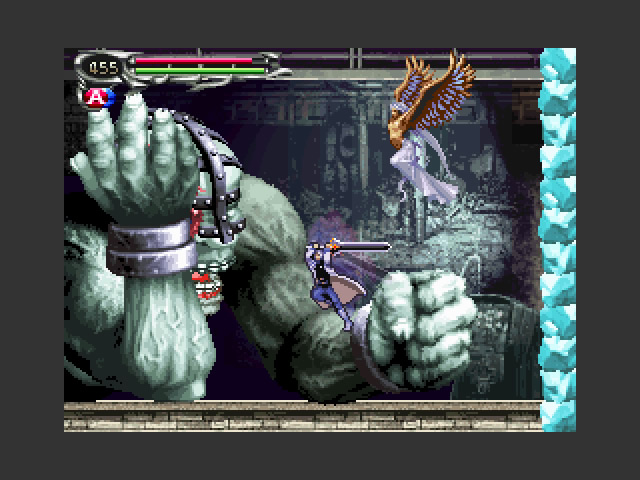Touching is good, but sucking is better.
Like the nigh-immortal vampire lying at the heart of the series, the Castlevania games simply refuse to die. While struggling to find a cozy niche on the current crop of consoles, the series that helped define the NES managed to remain in the spotlight by way of its spectacular suite of Game Boy Advance joy. Circle of the Moon, Harmony of Dissonance and Aria of Sorrow expanded on the ideas introduced in the Playstation sleeper Symphony of the Night, routinely receiving kudos from critics and fans alike.
It’s no surprise, then, that Castlevania: Dawn of Sorrow would emerge as a DS exclusive. It’s also unsurprising that it’s really good, another eminently playable, thoroughly enjoyable side-scrolling monster mash through another massive castle. In fact, there are so few surprises here that it’s almost, well, surprising how close to the vest the latest entry in this vaunted series plays it.
For a mythos that started off as a pretty straightforward tale of a vampire hunter chasing a vampire, Castlevania’s overarching plot has turned into something of an anime mess. Trying to follow the series timeline takes extensive use of pie charts and new math. Suffice to say, the various Belmont whipmasters who starred in all the early games have taken a backseat to a gang of ghost-chasing wunderkinds led by exchange-student/reincarnation of evil, Soma Cruz.
Soma’s story was first told in Aria of Sorrow, and despite the chronological inferences, Dawn of Sorrow is that game’s sequel. It turns out Soma escaped his fate of becoming the new Dracula, although that throne was never filled. This is apparently widespread news, and now a shadowy cult leader named Celia Fortner is attempting to bring forth the “Second Coming” (more like “Fifteenth”) of the dark lord and has found two potential hirees, Dario Bossi and Dmitri Blinov. You job is to infiltrate the cult’s base and stop them before this plot gets any more confusing.
Chances are, you’ll just bail out on the plot anyway to focus on Dawn of Sorrow‘s gameplay, another smooth mix of side-scrolling action and platforming with a healthy dose of RPG depth. Though it takes place at the cult’s supposed hideout, this looks astonishingly similar to the kind of labyrinthine fortress fans have come to expect from the series. How handy.
So off you go as Soma, whacking away at all sorts of nasty monsters in an effort to open up new areas of the castle, er, base. The game is just as reliant upon its combat as past iterations, perhaps more so thanks to its multi-pronged attack system. Basic weapon attacks see the most action, though each of the game’s dozen or so weapon types also has a super attack that uses up some MP. You can wield a few kinds of swords, axes, polearms, hammers and even some ranged weapons like boomerangs and the slightly out of place handguns. They all feel fairly different, too, with different swing rates and ranges. You’ll experiment a bit but will likely find a weapon that matches your play style and stick with it (until you happen upon a more powerful weapon of any type, that is).
 But that’s just the tip of this bloody iceberg. Soma can once again control the souls of monsters, which he collects by killing them in droves. There are three types of souls: Bullet, which tend to function as secondary ranged attacks; Guardian, which typically play as defensive spells or monster summons; and Enchant, which often tweak your stats.
But that’s just the tip of this bloody iceberg. Soma can once again control the souls of monsters, which he collects by killing them in droves. There are three types of souls: Bullet, which tend to function as secondary ranged attacks; Guardian, which typically play as defensive spells or monster summons; and Enchant, which often tweak your stats.
The first two types require MP to activate, while Enchant is just a constant cost-free effect. In a cool twist, you can accumulate up to nine of any soul, increasing its potency. The Une soul (a tiny shrub that acts like a mine), for instance, seems weak, but if you slaughter enough Une and have a stockade of nine, becomes a more brutal offensive weapon than many of the souls of stronger enemies. There are 116 different monsters in the game – every one of which has a unique soul attack – leading to a wonderfully varied beast of a system.
And it just gets beastlier. Fairly early on you gain the ability to equip two separate loadouts and toggle between them on the fly using the X button, essentially cutting down the need to slog through menus to change equipment. Souls can also be combined with weapons to create much stronger magic weapons not found in the game’s one store. Though the act of combining isn’t particularly deep, it adds some direction to the slaughter. Want to upgrade your Great Sword into the sexier Durandal? Time to go hunting for Valkyrie souls.
This all works in tandem with the classic Castlevania castle-as-puzzle design to form another strong RPG/platformer. You will again see spots on the very first screen you won’t be able to reach until you’ve gained some weird ability much later, and while the progression is fairly linear, it doesní¢â‚¬â„¢t feel like it since you spend a good amount of time backtracking to unlock previously inaccessible areas. Dawn of Sorrow‘s castle isn’t quite as complex as the multi-faceted map found in Harmony of Dissonance, but will keep you guessing nonetheless.
But what of the technology offered by the DS? Generally speaking, Dawn of Sorrow doesn’t take many interesting risks. The gameplay occurs solely on the bottom screen, leaving the top screen as either a snapshot of your inventory or the far more useful map. Navigating through the castle has never been easier.
The touch screen itself is used in two ways. Occasionally you’ll come across blocks of crystals, requiring you to use the stylus or your finger to break them up. The other use of the screen takes place only during boss fights. Upon defeating a boss, you have to trace the outline of a “magic seal” to do away with it completely; screw this up and it will regain some HP and require another beating.
 Neither gameplay device feels natural, instead drawing you out of the game to make you draw on the screen. It’s simply a poor use of the touch screen and feels like more of a nod to the tech than an intuitive part of the experience. Mercifully, most of the game has nothing to do with screen stroking
Neither gameplay device feels natural, instead drawing you out of the game to make you draw on the screen. It’s simply a poor use of the touch screen and feels like more of a nod to the tech than an intuitive part of the experience. Mercifully, most of the game has nothing to do with screen stroking
It does have to do with screen drooling, however, because this is a sharper looking game than its GBA brethren. Slicker animations and a solid, smooth framerate keep the action moving swiftly. The game’s signature bosses are well-detailed and pleasantly repulsive, complete with enormous attacks that take up most of the screen’s real estate. It isn’t a dramatic departure from the GBA games, just enough extra flash and sparkle to prove that it’s on a new system. The sound is also good, with catchy MIDI tracks and a wide variety of monster grunts and screams that sets the right mood and keeps it that way.
A straight shot through the game will take a mere six or seven hours, but no one plays Castlevania that way. Exploring the castle and trying to unlock the mysteries behind every closed door will take much longer, not to mention the three different endings. Beating the game also open up Julius Belmont mode, which lets you play through as the old whip-cracker himself. Other modes include a basic Wireless function that lets you trade souls with other players, a somewhat pointless ‘Enemy Set’ in which you build basic maps, set enemy locations and go at it, and the classic ‘Boss Rush,’ which skips right to the big boys.
While this vampire slayer doesn’t really take advantage of his newfound abilities and is mostly unchanged from his past iterations, you have to hand it to Konami for taking care of their baby. This is another fun, solid entry in what’s quickly becoming the most dependable series in handheld gaming. To truly become an unstoppable power, however, it will also have to become the most daring.
-
Sweet action and depth
-
Looks great
-
Classic design
-
Almost <em>too</em> classic
-
Marginal use of the DS capabilities











